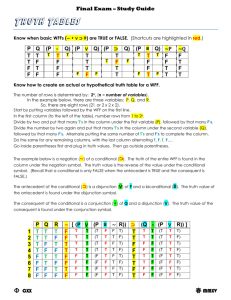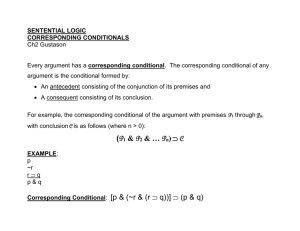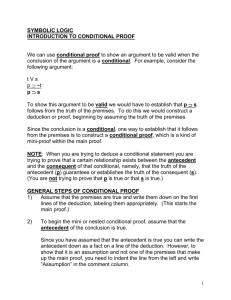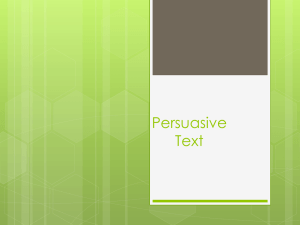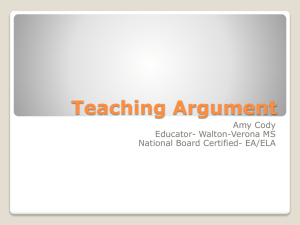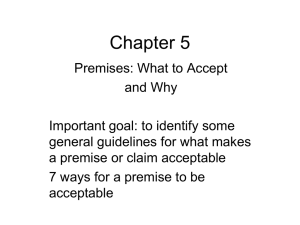Propositional Logic Part 2
advertisement
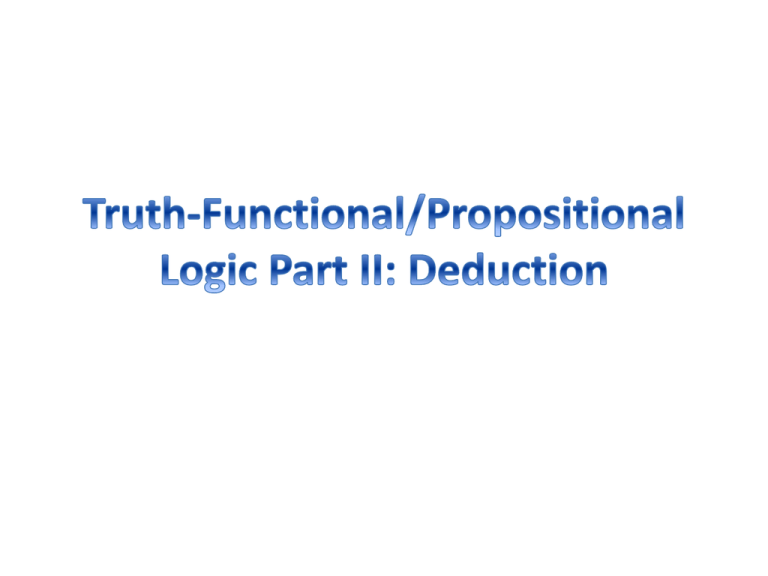
Use a truth table to determine the validity or invalidity of this argument. “Martin is not buying a new car, since he said he would buy a new car or take a Hawaiian vacation and I just heard him talking about his trip to Maui.” C or H H _ First, translate into standard form Not C Now , translate into symbols CvH H _ ~C 2 CvH H _ ~C Now, build a truth table. “C” and “H” each need a column and will serve as references. Next, we need a column for each premise and the conclusion. C T T F F H T F T F C v H ~C 3 CvH H _ ~C C T T F F H T F T F Fill in the truth values for the first premise based on the rule of disjunction: A disjunction is false if and only if both disjuncts are false. CvH T T T F ~C F F T T Our truth table now tells us whether or not the argument is valid. What do you think? 4 CvH H _ ~C Is it possible for the premises to be true and the conclusion false? C T T F F H T F T F CvH T T T F H T F T F ~C F F T T “Martin is not buying a new car, since he said he would buy a new car or take a Hawaiian vacation and I just heard him talking about his trip to Maui.” 5 O → (H & S) ~H v ~S _ ~O O T T T T F F F F H T T F F T T F F S T F T F T F T F ~H F F T T F F T T There are no cases where the premises are true and the conclusion false; this is a valid argument. Can you provide an interpretation? ~S F T F T F T F T H & S O → (H&S) ~H v ~S T T F F F T F F T F F T T T F F T T F T T F T T ~O F F F F T T T T 6 If side A has an even number, then side B has an odd number, but side A does not have an even number. Therefore, side B does not have an odd number. If side A has an even number, then side B has an odd number, but side A does not have an even number. Therefore, side A has an even number. If the theory is correct, then we will have observed squigglyitis in the speciment. However, we know the theory is incorrect. Therefore, we could not have observed squigglyitis in the specimen. If the theory is correct, then we will have observed dilation in the specimen. Therefore, since we did not observe dilation in the specimen, we know the theory is not correct. If we observe dilation in the specimen, then we know the theory is correct. We observed dilation, so the theory is correct. What conclusion does the following demonstrate to be true and how do you know it is true? P R. R S. P. / If the antecedent of a conditional appears on another line of the argument, the consequent of the conditional may be added as a line. How do you know the following are true: P&Q P P&Q Q A conjunction is true if and only if both conjuncts are true; therefore, if a conjunction is true, either and both conjuncts are also true. 3. R & S. S P. If the above is true, what else is true? S. P. What should the next line of the argument line be and how do you know? MP. (P & Q) R. S. S ~R. ~R. ~(P & Q) Now what should the next line be? Modus Tollens (MT): If a consequent of a conditional that appears as one premise appears appears as the negation of that consequent in another premise, then the negation of the antecedent should appear as the next line in the argument. 4. P→Q ~P → S ~Q /∴ S How do you know S is true if the premises are true? ~P 1, 3, S 2, 4, 7. ~S (P & Q) → R R→S /∴ ~(P & Q) How do you know ~(P & Q) is true if the premises are true? ~R 1, 3, ~(P & Q) 4, 2, 8. P → ~(Q & T) S → (Q & T) P /∴ ~S ~(Q & T) 1, 3, ~S 2, 4, P→Q R→S PvR /∴ Q v S How do you know Q v S is true? The disjunction of the antecedents of any two conditionals allows the derivation of the disjunction of their consequents. 2. P→S PvQ Q→R /∴ S v R How do you know S v R is true? 1, 2, 3, 5. (P v Q) → R Q /∴ R How do you get to R? ): The truth of one disjuct makes the entire disjunction true. 1. R→P Q→R /∴ Q → P How we get to Q → P? You can create a new conditional from two other conditionals, provided that the antecedent of one existing conditional appears as the consequent of the other existing conditional. 9. (P v T) → S R→P RvQ Q→T /∴ S Talk us to S. 2, 3, 4, 1, 5, 6. 1, 3, MP ~P ~(R & S) v Q ~P → ~Q /∴ ~(R & S) ~(R & S) 2, 4, Disjunctive Argument (DA): The negative of one disjunct in a disjunction implies the truth of the other disjunct.
